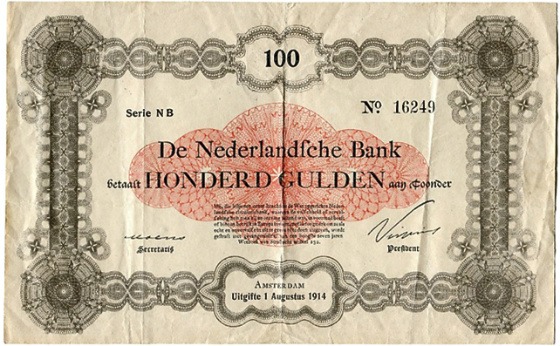New record set for Dutch banknote
 At a recent auction in Zürich, Switzerland, a record was set for the most expensive banknote from The Netherlands in history, as Coinweek reports. Being Dutch myself, this of course is fascinating to me. Previously the most expensive banknote was a 200-gulden note from 1860 which sold for €44,280 in 2013.
At a recent auction in Zürich, Switzerland, a record was set for the most expensive banknote from The Netherlands in history, as Coinweek reports. Being Dutch myself, this of course is fascinating to me. Previously the most expensive banknote was a 200-gulden note from 1860 which sold for €44,280 in 2013.
The new record holder is a 100-gulden note from 1914 which has skyrocketed to $96,325 (about €87,357). The buyer was Amsterdam dealer Theo Peters, who said he was "pleased with the note and of its quality". Some interesting history on the note, from Coinweek:
Patrick Plomp, dealer, researcher and author of the Catalog of Netherlands Paper Money, 1573–2002 (2014, www.patrickp.nl), knows of only two other examples, both in the collection of De Nederlandse Bank, the Dutch central bank. One is a specimen issue with serial number 00000, the other a perforated canceled note with number 75204, making the Sincona piece the only known example not turned in and destroyed.
Het Nederlandse Bankbiljet 1814-2002 vormgeving en ontwikkeling (“The Dutch Banknote 1814-2002 Design and Development”), second edition by J. Bolten, P.J. Soetens, J.J. Grolle, and P. Koeze, sheds light on this rare and important piece of financial history for Netherlands. It was an emergency note issued on Aug. 4, 1914, designed and printed by Joh. Enschedé en Zonen in Haarlem, the security printing firm that still prints euro bank notes for Netherlands today. The archives of the Dutch National Bank report a production of 100,000 pieces with series NB, and 50,000 with series NC notes. The 1,000-gulden note was also produced and issued, but records show all were accounted for when they were taken out of circulation and canceled on March 27, 1923. Also, 300- and 200-gulden notes were created but not issued.
The 100-gulden note was revoked by royal decision 43, dated May 10, 1928, and the official recall notice was issued on May 29, 1928. The actual out-of-circulation date was May 25, 1929, after which it was no longer possible to convert it to new money. On May 30, 1939, 10 notes were still outstanding. As they were not returned, they were written off the books and their value added to the profit of the central bank.











No comments